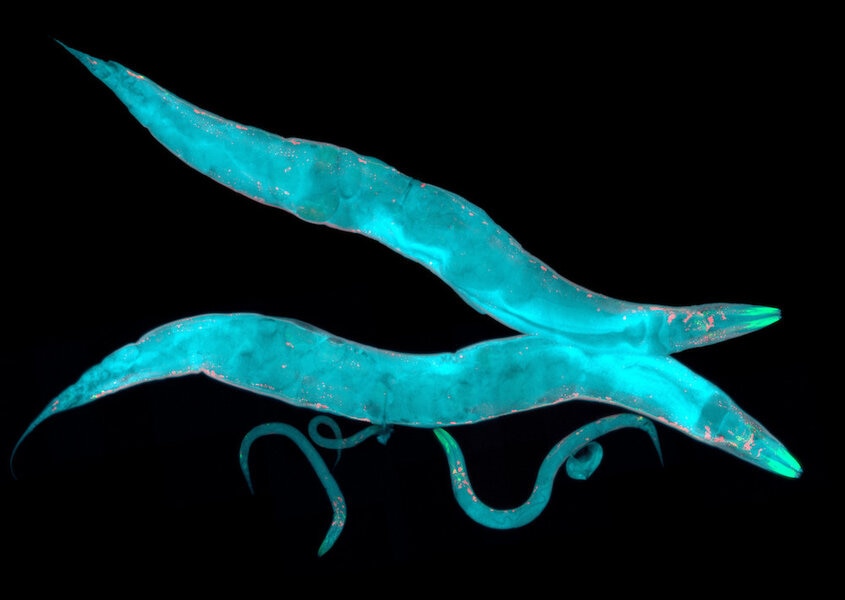Create a free profile to get unlimited access to exclusive videos, sweepstakes, and more!
How The Thing (And Other Creatures) Survive Years Frozen in Ice
The solution is pretty sweet.
Anyone who has ever plucked chicken nuggets from the freezer knows that if you want to keep something preserved long term, it helps to keep it cold. Most of our planet experiences annual seasonal variation, swinging back and forth between cold winters and warm summers to varying degrees. The polar regions, however, stay cold pretty much all of the time, making them useful repositories of ancient information. To that end, small teams of scientists hole up in Antarctic research stations to study the Earth’s deep past.
One such team (fictional as they might be) set up in Antarctica back in 1982 and found something buried in the ice which threatened their lives and the lives of all of humanity. There, separated from the rest of humanity, Antarctic explorers uncovered an alien spacecraft buried in the ice for 100,000 years. Any reasonable person might assume that would be a death sentence, but The Thing (streaming now on Peacock) was simply biding its time and waiting for the right moment to rise again.
RELATED: Scientists Sent an Underwater Robot to Figure Out What’s Killing the Doomsday Glacier
For better or for worse, aliens aren’t the only creatures capable of enjoying a second wind after a few thousand years in stasis. If you want to find weird creatures freezing their way into the future, you need look no further than our planet.
Wood Frogs Time Hop Through the Winter
Wood frogs are contrarians by nature, discarding all of the unwritten rules about being a frog. While their relatives are enjoying tropical rainforests and temperate ponds, wood frogs have settled the frigid terrains of Canada and Alaska. Temperatures in their natural habitat regularly swing from 90 Fahrenheit (32 Celcius) in the summer to -50 Fahrenheit (-45 Celsius) in the winter.
Like other amphibians, wood frogs are cold blooded, so when the temperatures drop below freezing, so do the frogs. In other parts of the world, frogs descend to the bottom of lakes and rivers in the winter where the water gets cold but not below freezing. Wood frogs, by contrast, simply walk into the woods, settle into the leaf litter, and allow themselves to become frogcicles. That should kill them, but thanks to an evolutionary trick, when temperatures rise in the spring, so do the frogs.
Before freezing, their tiny frog liver dumps a whole bunch of glucose into the circulatory system. They produce so much glucose that it saturates their cells and binds with water molecules. That glucose prevents water from binding together into ice crystals which would damage cells, resulting in death. Overwintering wood frogs have been found with blood glucose levels 100 times higher than normal. They’re basically little frog-shaped slushees waiting to melt.
Water Bears and Worms Freeze for Decades, Eons
Nematodes (microscopic roundworms) are some of the most widespread and well-studied animals in the world. It has been said that there are so many nematodes living in so many disparate environments, that if the entire Earth, save for the nematodes, were to vanish you would still be able to see the ghostly image of the planet in their wriggling wormy bodies.
These tiny transparent worms are happy living in deserts, swamps, the soil in your backyard, and even the frigid wastes of the world’s coldest places. In a study published in July 2023, researchers describe a newly discovered species of nematode worm, found 40 meters deep in the Siberian permafrost. The worms were in a state of cryptobiosis (fancy talk for being frozen but not dead) during which metabolic processes stopped completely. In that state, an animal can survive in a kind of suspended animation without access to food, water, or oxygen. Waking the worms up was a simple matter of allowing their temperature to rise and rehydrating them.
RELATED: John Carpenter Confirms He Knows Who Was Human at the End of 1982's The Thing
That’s pretty normal behavior for a lot of microscopic creepy crawlies. Tardigrades, also known as water bears, are probably the most famous. When they lock their bodies down, they can survive extreme heat, cold, and exposure to radiation. They’ve even survived being dumped in the vacuum of space. In 2022, scientists revived tardigrades after a 30-year nap inside a research freezer. That’s pretty impressive, but it’s nothing compared to the Siberian nematodes.
To find out just how old their frozen worms were, scientists dated plant material found inside the ice alongside the worms. When the numbers came back, they broke every record at a staggering 46,000 years. Like the wood frog, the worms produce a type of glucose which floods their system and likely protects them from the ravages of ice, allowing them to wake up and get back to living even tens of thousands of years down the line. Sugar is the key.
All of which means that even though The Thing body snatched a bunch of people and threatened the human race, it probably tastes delicious. Unfortunately, in the heat of the moment, no one thought to try it.
Catch The Thing, streaming now on Peacock.































